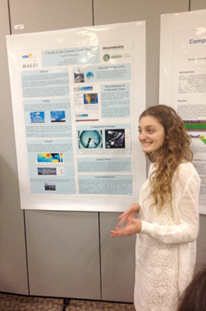Collaborating with MAGIC
Published: 21 February 2014
Editor’s note: Ernie Lewis, principal investigator for the Marine ARM GPCI Investigations of Clouds (MAGIC) field campaign, sent this update.
MAGIC has still been active and keeping me busy, despite my lapse in writing updates. We left off with a description of presentations to be made at the MAGIC session of the Atmospheric System Research (ASR) Fall Working Group Meeting in November. ASR is a program of the U.S. Department of Energy whose goal is to fund research to better understand interactions among aerosols, clouds, precipitation, and radiation. The session was well attended and quite successful, with a number of investigators already looking at MAGIC data and comparing results from different instruments.
There is another ASR meeting next month, the Science Team Meeting, during which there will also be a session on MAGIC. I am lining up speakers, and it looks as if it too will be an interesting session. Two graduate students I invited to present during this session, Xiaoli Zhou from McGill University in Montreal and Trevor Ferguson from University of Utah, will be giving presentations involving MAGIC data to the entire science team. I am looking forward to hearing about their results.
There was also a December session on MAGIC at the American Geophysical Union (AGU) Conference in San Francisco, California. This is a very large conference with roughly 20,000 attendees covering all aspects of geophysics—clouds, aerosols, atmospheric electricity, other planets, earthquakes, volcanoes, etc. There were around 20 posters in the MAGIC session, and it was great for me to meet and get to talk to some of the people interested in MAGIC. I find meetings like this to be very useful, as they draw together scientists who can discuss their interests and needs, share results, and form collaborations in a way that would be impossible without meeting face to face.
For these same reasons, the first MAGIC Science Workshop will take place at Brookhaven National Laboratory (BNL) in May of this year. It will be a great opportunity for those working on MAGIC to meet each other, find out the status of data processing, present results, form collaborations, discuss future research and directions. The amount of data collected during MAGIC is vast, with nearly 200 days at sea and three-dozen instruments, and covers an array of topics in atmospheric science. This amount of data is more than any one person can handle, and the questions that can be addressed cover to a wide range of interests.

As I have often stated, one of the most rewarding aspects of my involvement with MAGIC has been interacting with wonderful people—other scientists, the captain and crew of the Spirit, and students at all levels. Last summer two university students, Danielle Mallon and Michelle Gostic, were in a program that allowed them to come to BNL, where they worked with me on MAGIC data. Danielle is back in Albany, where she graduated last spring. She is now getting a Master’s degree in geographic information systems and is working at the New York State Department of Environmental Conservation. Michelle is spending her junior year at Cornell University abroad at the Universidad de Cantabria in Santader, Spain.
I also had the pleasure working with Sarah Monastero last summer, who is now a senior at Sayville High School on Long Island. She calculated times when satellites would be over the ship so we would know what relevant satellite images to obtain. She has applied, and accepted, to several universities and is planning on majoring in civil engineering with a focus on sustainability.
Currently, there are two students in our department: Bunheng Ty, who is working on a project involving optics, and Anastasia Maydanov, who is working on MAGIC data. Ty just graduated with a bachelor of science in physics and is deciding what graduate school he will attend in the fall. Anastasia is a chemistry major at Northeastern University in Boston and is spending this term at BNL as part of her internship program. She came with no previous programming experience, so I had her immerse herself in learning the programming package we use here (IGOR) so that she could process MAGIC data and make graphs for me for an upcoming presentation.
In my opinion, learning from others, and sharing what you know with them, is a vital part of science, which is intrinsically a collaborative process.
Ernie Lewis
The ARM Climate Research Facility is a DOE Office of Science user facility. The ARM Facility is operated by nine DOE national laboratories, including .
Keep up with the Atmospheric Observer
Updates on ARM news, events, and opportunities delivered to your inbox
ARM User Profile
ARM welcomes users from all institutions and nations. A free ARM user account is needed to access ARM data.


















